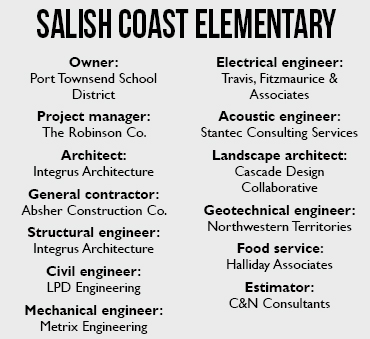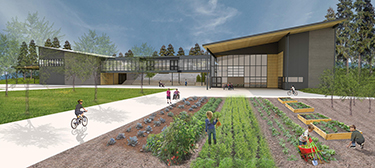|
Subscribe / Renew |
|
|
Contact Us |
|
| ► Subscribe to our Free Weekly Newsletter | |
| home | Welcome, sign in or click here to subscribe. | login |
Construction
| |
 |
August 24, 2017
Outdoor learning labs let children connect to nature
Integrus Architecture

Payton
|
At the narrow passage into the Puget Sound is a small maritime community that is using the school design and construction process as an opportunity to reinvigorate the aspirations of the local community.
Voters in the Port Townsend School District approved a $40.9 million bond in 2016 to replace Grant Street Elementary School.
The school will also get a new name: Salish Coast Elementary School.
Well before the design team was selected and the bond was brought to the voters, key community stakeholders recognized that the prospects of the community were directly tied to how well its young people were educated and prepared for their futures there.
This dedicated group of local leaders met monthly for two years, distilling project goals and laying the groundwork for a school that would be fully integrated into the life of the community. The district was also expanding school programs such as the community and school vegetable garden, wellness and nutrition programs, and a bikeable/walkable schools initiative.
These programs were developed to nurture students’ growth in a learning culture designed to serve as an example of how best to live as a citizen of the world.
A civic resource
Once the design team, led by Integrus Architecture, was selected, a series of workshops were held to further articulate and define how the new school would support a culture where students thrive.
District staff envisioned the school should:

• Foster deep collaboration between students, teachers, school staff and community.
• Be a safe, secure and welcoming environment where students are encouraged to take risks, and mistakes are appreciated.
• Create a seamless connection to nature with easy access to outdoor learning and playing.
Together, community stakeholders, district leadership, teaching staff and the design team challenged each other to explore what it means to collaborate deeply in teaching and learning, reimagining the classroom as a safe launching pad for elementary students as they explore their community and the world around them.
Regularly teaming with local leaders in maritime and marine biology fields rigorously engages students in hands-on math and science education. Students of the Maritime Discovery program are often found outdoors, crafting sails for a historic wooden ship or collecting water samples from a stream swimming with salmon.
Just as the education model depends on its community to engage in real-world problem-solving experiences for students, Salish Coast Elementary was conceived to support and serve its community as an important civic amenity. The dual use of the new school’s library as a branch location for the city’s public library system is an example of this school-community synergy.
Central courtyard
Fostering a concept of “no child left indoors,” Salish Coast Elementary is designed to encourage outdoor learning.
Key to this ideal is the creation of a central courtyard where teachers and students, within a protected environment, are directly connected to the outdoors in their daily routines.
The courtyard is programmed as a dynamic and living learning environment to host and inspire daily lessons. Its design also prioritizes pedestrian access to the site.
The entry sequence is characterized by a series of courtyards and gardens that lead students and community members from the lower level, which is zoned for public spaces and amenities, into the intimately scaled upper level and interior learning courtyard.
In a school where learning happens everywhere, creating a seamless connection to nature means promoting easy access to the outdoors. This is done by extending the transition between indoor and outdoor spaces.
Punctuated by a rhythm of covered, outdoor nature labs, the interior courtyard was integrated with the building mass to maximize daylight and break up the space into a series of smaller learning and socializing zones.
Hugged by an existing forest of evergreens, the uniquely Pacific Northwest site is honored through the celebration of the water cycle, use of native plantings, broad overhangs and other environmental considerations, including a photovoltaics-ready roof.
Flexible spaces
Through an iterative design discovery process, stakeholders learned to accept a level of trust around embracing change and fostering a deep collaboration among students, teachers, school staff and community.
With the basic classroom unit and square footage still in flux, the planning team explored several configurations of space and learning blocks that support both collaborative teaching and lower teacher-student ratios. Variations of these include parallel teaching, lead and support, station teaching, and teaming, all of which require highly adaptable learning settings to be successful.
To support this, architectural features were developed to imply different zones for multiple concurrent activity settings. Using “T”-shape and “L”-shape classrooms — ideal layouts to encourage a wide range of learning — the design team arrived at a solution for flexible learning settings defined by a variety of ceiling heights and slopes that create subspaces within each room.
Openings between classrooms expand and contract the learning unit, reinforcing collaboration on a grade-level basis, as well as supporting changing student populations and curriculums over time. Strategic use of flexible and movable furniture and casework contributes to the speed and ease of changing activities and learning needs.
An exceptional client with a clear vision and uniquely engaged community planning process has resulted in a new facility that is a welcoming, nurturing and lasting amenity to the community as it serves to educate and transform elementary school students for generations to come.
Shannon Payton is an associate with Integrus Architecture and the project designer for Salish Coast Elementary School.
Other Stories:
- Giant murals give students ‘something to look at and feel proud’
- Seattle’s Lincoln High to reopen 38 years after closing
- Tahoma High project makes the best of a hilly site on former golf course
- North Seattle elementary supports students by opening its doors to families
- Designers study Tinkertoy-inspired school 20 years later to see what worked
- High schoolers get real-life work experience in health sciences building
- 2 new buildings that push students to become more engaged learners
- Classroom wing provides West Sound’s first new STEM space
- Why an old church could make a good place for a charter school




